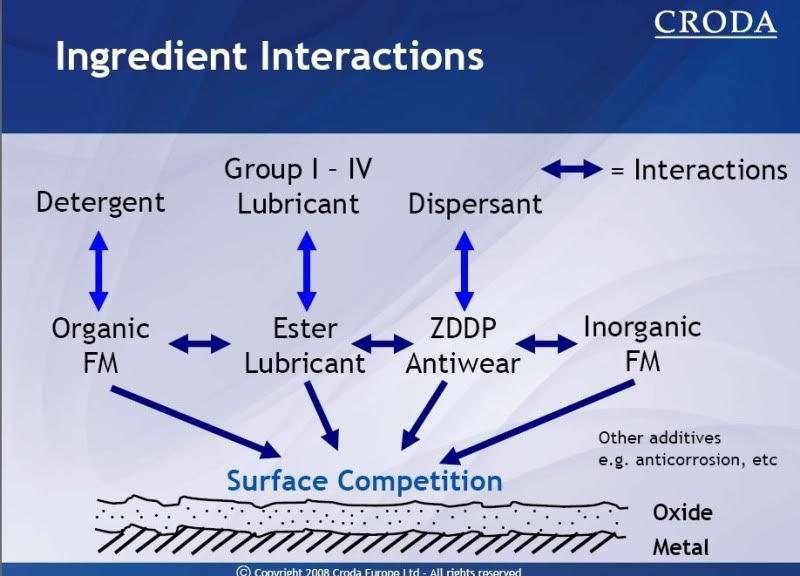From left to right Factory Fill, MC 5w30 GC 0w30, Shell Rotella T Syn 5w40, Amsoil Euro 5w40, Bruce Blend 5w40, Mobil 1 Turbo Diesel Truck, Mobil 1 Turbo Diesel Truck, and RLI 5w40HD
Miles on Sample 1274 1750 4211 1376 4512 2936 3319 4051 4362
Iron 14 10 16 8 13 16 13 9 17 (ELEVATED FROM ESTER BASED OIL CLEANING)
Chrom 0 0 1 0 0 1 0 1 1
Lead 0 0 0 0 0 0 0 1 1
Copper 187 75 114 40 13 6 4 4 98 (part of add pack, usually around 200 in VOA)
Tin 0 5 0 0 1 1 0 0 0
Alum 5 6 6 0 3 2 4 2 3 (ELEVATED IN SYNCH WITH IRON, PISTON, CYLINDER, AND CHAIN CLEANING)
Nickel 0 0 0 0 0 0 0 0 0
Silver 0 0 0 0 0 0 0 0 0
Sil 59 19 10 5 3 3 4 3
Boron 6 154 28 5 52 18 47 36 5
Sodium 0 0 0 3 5 11 7 13 20
Magni 19 13 473 94 20 9 606 577 117
Calc 1706 2027 1931 3328 1843 1730 1282 1000 2726
Barium 0 0 0 0 0 85 15 1 0
Phos 944 935 1006 1425 753 1428 1008 1013 1390
Zinc 1044 1050 1115 1454 948 875 1102 1043 1600
Moly 100 48 9 2 0 1 2 3 0
Titan 0 0 0 0 0 0 0 0 0
Van 0 0 0 0 0 0 0 0 0
Potas 0 0 0 0 2 2 1 1 1390
Antim 0 0 0 0 2 2 0 0 111
Fuel% Visc @100c cst 9.06 8.59 10.87 12.8 11.73 11.68 11.9 12.8 13.2
Water% NA NA NA Coolant NO NO NO NO NO Soot N/A N/A N/A TBN 4.84 5.14 6.04 9.48 3.25 4.79 3.83 6.1 7.4
Nitr N/A N/A N/A 15 NA 19 11 12
Oxid N/A N/A N/A 11 NA 20 20 138 (STARTS AT 154, COMMON WITH ESTER BASED OILS)
Flash 380 260 (STARTES AT 375 CLOSED CUP, 428 OPEN CUB)
TAN 3.24 NOT DETECTABLE DUE TO COLOR OF OIL FROM CLEANING
VI 166 (starts at 167) 189 (STARTS AT 189)
Dyson anlaysis. Fuel was no doubt from the excessively low temps this winter so far. Im rather impressed, thought FE would be higher from the cleaning. Will be sampling at 6K, but not draining unless directed from analysis.
Miles on Sample 1274 1750 4211 1376 4512 2936 3319 4051 4362
Iron 14 10 16 8 13 16 13 9 17 (ELEVATED FROM ESTER BASED OIL CLEANING)
Chrom 0 0 1 0 0 1 0 1 1
Lead 0 0 0 0 0 0 0 1 1
Copper 187 75 114 40 13 6 4 4 98 (part of add pack, usually around 200 in VOA)
Tin 0 5 0 0 1 1 0 0 0
Alum 5 6 6 0 3 2 4 2 3 (ELEVATED IN SYNCH WITH IRON, PISTON, CYLINDER, AND CHAIN CLEANING)
Nickel 0 0 0 0 0 0 0 0 0
Silver 0 0 0 0 0 0 0 0 0
Sil 59 19 10 5 3 3 4 3
Boron 6 154 28 5 52 18 47 36 5
Sodium 0 0 0 3 5 11 7 13 20
Magni 19 13 473 94 20 9 606 577 117
Calc 1706 2027 1931 3328 1843 1730 1282 1000 2726
Barium 0 0 0 0 0 85 15 1 0
Phos 944 935 1006 1425 753 1428 1008 1013 1390
Zinc 1044 1050 1115 1454 948 875 1102 1043 1600
Moly 100 48 9 2 0 1 2 3 0
Titan 0 0 0 0 0 0 0 0 0
Van 0 0 0 0 0 0 0 0 0
Potas 0 0 0 0 2 2 1 1 1390
Antim 0 0 0 0 2 2 0 0 111
Fuel% Visc @100c cst 9.06 8.59 10.87 12.8 11.73 11.68 11.9 12.8 13.2
Water% NA NA NA Coolant NO NO NO NO NO Soot N/A N/A N/A TBN 4.84 5.14 6.04 9.48 3.25 4.79 3.83 6.1 7.4
Nitr N/A N/A N/A 15 NA 19 11 12
Oxid N/A N/A N/A 11 NA 20 20 138 (STARTS AT 154, COMMON WITH ESTER BASED OILS)
Flash 380 260 (STARTES AT 375 CLOSED CUP, 428 OPEN CUB)
TAN 3.24 NOT DETECTABLE DUE TO COLOR OF OIL FROM CLEANING
VI 166 (starts at 167) 189 (STARTS AT 189)
Dyson anlaysis. Fuel was no doubt from the excessively low temps this winter so far. Im rather impressed, thought FE would be higher from the cleaning. Will be sampling at 6K, but not draining unless directed from analysis.

